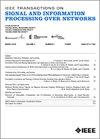多路径阻塞环境下被动多目标定位的鲁棒LOS识别
IF 3
3区 计算机科学
Q2 ENGINEERING, ELECTRICAL & ELECTRONIC
IEEE Transactions on Signal and Information Processing over Networks
Pub Date : 2025-08-20
DOI:10.1109/TSIPN.2025.3600826
引用次数: 0
摘要
本文考虑使用多个空间分布的传感器进行被动目标定位,每个传感器发射不同的波形来测量来自被动目标的视线(LOS)和非视线(NLOS)延迟。由于LOS和NLOS测量不能直接区分,问题是在某些传感器与某些目标之间被阻挡时识别LOS测量-没有事先知道哪些传感器或目标受到影响-并且场景中存在的目标总数是先验未知的。利用目标可以根据阻碍它们的传感器数量划分为不同级别的事实,我们提出了一种基于分层类型的聚类算法(HiTCA),该算法采用多级搜索策略,每个搜索策略都设计用于识别一个特定级别的目标。这些搜索可以跨层并行执行,以有效地识别具有不同LOS阻塞程度的目标。此外,我们利用了多级搜索结果之间的差值,这使我们能够获得目标总数的可靠推断。大量的计算机仿真表明,在多目标多径阻塞环境下,与现有方法相比,该方法具有更好的性能。本文章由计算机程序翻译,如有差异,请以英文原文为准。
Robust LOS Identification for Passive Multi-Target Localization in Multipath Obstructed Environments
This paper considers passive target localization using multiple spatially distributed sensors, each transmitting distinct waveforms to measure line-of-sight (LOS) and non-line-of-sight (NLOS) delays from the passive targets. Since LOS and NLOS measurements are not directly distinguishable, the problem is to identify the LOS measurements when certain sensors are blocked from some targets—without prior knowledge of which sensors or targets are affected—and the total number of targets present in the scene is unknown a priori. Leveraging the fact that targets can be categorized into different levels according to the number of sensors obstructed from them, we propose a hierarchical type-based clustering algorithm (HiTCA), which employs a multi-level search strategy, with each designed to identify one specific level of targets. These searches can be performed in parallel across levels to efficiently identify targets with different extents of LOS blockage. Moreover, we exploit a spread difference among the multi-level search results, which enables us to obtain a reliable inference of the total target number. Extensive computer simulations show that the proposed technique obtains superior performance compared to existing methods in multi-target multipath environments with blockage.
求助全文
通过发布文献求助,成功后即可免费获取论文全文。
去求助
来源期刊

IEEE Transactions on Signal and Information Processing over Networks
Computer Science-Computer Networks and Communications
CiteScore
5.80
自引率
12.50%
发文量
56
期刊介绍:
The IEEE Transactions on Signal and Information Processing over Networks publishes high-quality papers that extend the classical notions of processing of signals defined over vector spaces (e.g. time and space) to processing of signals and information (data) defined over networks, potentially dynamically varying. In signal processing over networks, the topology of the network may define structural relationships in the data, or may constrain processing of the data. Topics include distributed algorithms for filtering, detection, estimation, adaptation and learning, model selection, data fusion, and diffusion or evolution of information over such networks, and applications of distributed signal processing.
 求助内容:
求助内容: 应助结果提醒方式:
应助结果提醒方式:


